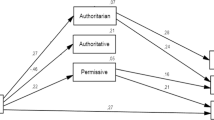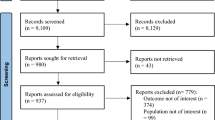Abstract
The hostile attributional tendencies of maltreated children in elementary school across key relationship figures (i.e., parents, teachers, and peers), the relation between children's hostile attributional tendencies and the frequency and severity of maltreatment, and the role of children's hostile attributions of their parents in mediating the relation between maltreatment and children's hostile attributions of unfamiliar peers were examined. The sample consisted of 44 maltreated and 56 nonmaltreated children (females = 51) of mixed ethnicity. Subjects were administered a 20-item measure of attributional processes. The results indicated that relative to nonmaltreated children, physically abused boys were more likely to attribute hostile intentions to a variety of relationship figures, including their parents, an unfamiliar teacher, their best friend, and unfamiliar peers. A positive relation was also found between the frequency of physical abuse and hostile attributional tendencies among males. Finally, support was found for the role of children's hostile attributions of their mothers in mediating the relation between physical abuse and children's hostile attributions of unfamiliar peers. The results support a link between physical abuse and hostile attributional tendencies in children in early elementary school.
Similar content being viewed by others
References
Barnett, D., Manly, J. T., & Cicchetti, D. (1993). Defining child maltreatment: The interface between policy and research. In D. Cicchetti & S. L. Toth (Eds.), Child abuse, child development, and social policy (pp. 7-74). Norwood, MY: Ablex.
Baron, R. M., & Kenny, D. A. (1986). The moderator–mediator variable distinction in social psychological research: Conceptual, strategic and statistical considerations. Journal of Personality and Social Psychology, 51, 1173-1182.
Bowlby, J. (1973). Attachment and loss: Vol. 1. Separation. New York: Basic Books.
Bretherton, I. (1991). Pouring new wine into old bottles: The social self as internal working model. In M. Gunnar & L. A. Sroufe (Eds.), The Minnesota Symposia on Child Development: Vol. 32: Self-processes and development (pp. 1-41). Hillsdale, NJ: Erlbaum.
Buchsbaum, H. D., Toth, S. L., Clyman, R. B., Cicchetti, D., & Emde, R. N. (1992). The use of a narrative story stem technique with maltreated children: Implications for theory and practice. Development and Psychopathology, 4, 603-625.
Cicchetti, D., & Lynch, M. (1995). Failures in the expectable environment and their impact on individual development: The case of child maltreatment. In D. Cicchetti & D. J. Cohen (Eds.), Developmental psychopathology (pp. 32-71). New York: Wiley.
Cohen, J. (1960). A coefficient of agreement for nominal scales. Educational and psychological Measurement, 20, 37-46.
Crick, N., & Dodge, K. A. (1994). A review and reformulation of social information–processing mechanisms in children's social adjustment. Psychological Bulletin, 115, 73-101.
Crittenden, P. M. (1988). Family and dyadic patterns of functioning in maltreating families. In K. Browne, C. Davies, & P. Stratton (Eds.), Early prediction and prevention of child abuse, (pp. 161-189). Chichester, U.K.: Wiley.
Crittenden, P. M., & Ainsworth, M. D. S. (1989). Child maltreatment and attachment theory. In D. Cicchetti (Ed.), Child maltreatment (pp. 432-463). New York: Cambridge University Press.
Dean, A. L., Malik, M. M., Richards, W., & Stringer, S. A. (1986). Effects of parental maltreatment on children's conceptions of interpersonal relationships. Developmental Psychology, 22, 617-626.
Dodge, K. A. (1980). Social cognition and children's aggressive behavior. Child Development, 51, 162-170.
Dodge, K. A. (1993). Social–cognitive mechanism in the development of conduct disorder and depression. Annual Review of Psychology, 44, 559-584.
Dodge, K. A., Pettit, G. S., & Bates, J. E. (1990). Mechanisms in the cycle of violence. Science, 250, 1678-1683.
Dodge, K. A., & Price, J. M. (1994). On the relation between social information processing and socially competent behavior in early school-aged children. Child Development, 65, 1385-1397.
Dodge, K. A., Price, J. M., Bachorowski, J., & Newman, J. P. (1990). Hostile attributional biases in severely aggressive adolescents. Journal of Abnormal Psychology, 99, 385-392.
English, D., Marshall, D. B., Brummel, S., & Orme, M. (1999). Characteristics of repeated referrals to child protective services in Washington State. Child Maltreatment, 4, 297-307.
Erickson, M. R., & Egeland, B. (1996). Child neglect. In J. Birere, L. Berliner, J. Bukley, C. Jenney, & T. Reid (Eds.), The APSAC handbook on child maltreatment (pp. 4-20). Thousand Oaks, CA: Sage.
Furman, W., & Buhrmester, D. (1985). Children's perceptions of the personal relationships in their social networks. Developmental Psychology, 21, 1016-1024.
Gaudin, J. M., Polansky, N. A., Kilpatrick, A. C., & Shilton, P. (1996). Family functioning in neglectful families. Child Abuse and Neglect, 4, 363-377.
Hollingshead, A. B. (1979). Four factor index of social status. Unpublished manuscript, Yale University.
Lynch, M., & Cicchetti, D. (1991). Patterns of relatedness in maltreated and nonmaltreated children: Connections among multiple representational models. Development and Psychopathology, 3, 207-226.
Manly, J. T., Cicchetti, D., & Barnett, D. (1994). The impact of subtype, frequency, chronicity, and severity of child maltreatment on social competence and behavior problems. Development and Psychopathology, 6, 121-143.
McCrone, R. R., Egeland, B., Kalkoske, M., & Carlson, E. A. (1994). Relations between early maltreatment and mental representations of relationships assessed with projective storytelling in middle childhood. Development and Psychopathology, 6, 99-120.
Miller, G. A., & Chapman, J. P. (2001). Misunderstanding analysis of covariance. Journal of Abnormal Psychology, 5, 40-48.
Price, J. M. (1996). Friendships of maltreated children and adolescents: Contexts for expressing and modifying relationship history. In B. Bukowski, A. Newcomb, & W. W. Hartup (Eds.), The company they keep: Friendship during childhood and adolescence. New York: Cambridge University Press.
Price, J. M., & Dodge, K. A. (1989). Peers' contribution to children's social maladjustment: Description and intervention. In T. J. Berndt & G. W. Ladd (Eds.), Peer relations in child development (pp. 341-370). New York: Wiley.
Price, J. M., & Van Slyke, D. (1991, April). Social information–processing patterns and social adjustment of maltreated children. Paper presented at the biennial meeting of the Society for Research in Child Development, Seattle, WA.
Westen, D. (1991). Social cognition and object relations. Psychological Bulletin, 109, 429-455.
Author information
Authors and Affiliations
Rights and permissions
About this article
Cite this article
Price, J.M., Glad, K. Hostile Attributional Tendencies in Maltreated Children. J Abnorm Child Psychol 31, 329–343 (2003). https://doi.org/10.1023/A:1023237731683
Issue Date:
DOI: https://doi.org/10.1023/A:1023237731683




